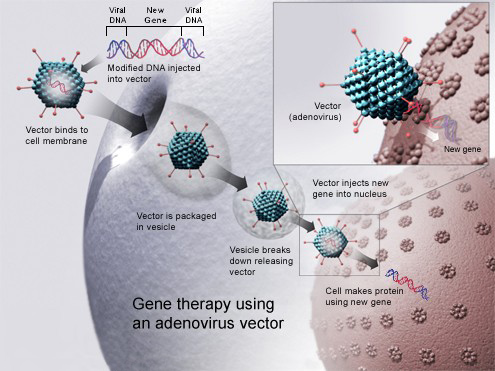Gene therapy is a technique used to correct defective genes– genes that are responsible for disease development. Specifically, according to the American Society of Gene and Cell Therapy-
“Gene therapy is defined as a set of strategies that modify the expression of an individual’s genes or that correct abnormal genes. Each strategy involves the administration of a specific DNA (or RNA).â€
Gene therapy is the manipulation of the expression of specific genes in a person’s body, in hopes of treating a disease or disorder. Gene therapy is still considered experimental and only available via clinical trial. Although many successful trials have been documented (see ‘Interesting Links’ below), gene therapy has a checkered history. In some gene therapy trials, there were cases of leukemia as an unintended side-effect, and even cases of death (see link on Jesse Gelsinger below).

How Does Gene Therapy Work?
Although there are several strategies for gene therapy, the most commonly used method involves inserting a ‘therapeutic’ gene into the genome to replace the ‘abnormal’ or ‘disease-causing’ gene. The gene that is inserted is delivered into a target cell via a ‘vector’. Usually, this vector is a virus, although non-viral vectors are in development. Viruses are a good choice for introducing genes into a cell because they typically operate by transferring their own genetic material while replicating themselves. Once target cells are infected with the viral vector, the vector releases its therapeutic gene which then incorporates into the cell’s DNA.  The goal is that the cell will start using the new gene to make functional, healthy proteins.
There are three main strategies for using gene therapy to restore the target cells or target tissues to a normal, healthy state.
1. Insert the functional version of a gene in hopes of replacing the abnormal form. This is used to treat single-gene disorders like hemophilia A and B and cystic fibrosis.
2. Insert a gene that encodes for a ‘therapeutic protein’ that treats a disease. This is used to treat acquired diseases like infection or ischemic heart disease.
3. Use gene transfer to down-regulate gene expression in hopes of decreasing the activity of a harmful gene.
Current Areas of Research
Although gene therapy is still experimental, many diseases have been targets for gene therapy in clinical trials. Some of these trials have produced promising results. Diseases that may be treated successfully in the future with gene therapy include (but are not limited to):
* Anemias
* Cardiovascular diseases
* Cystic Fibrosis
* Diabetes
* Diseases of the bones and joints
* Eye disease and Blindness
* Gauscher’s Disease
* Hemophilia
* Huntington’s Disease
* Lysosomal storage diseases
* Muscular Dystrophy
* Sickle cell disorder
The main challenges facing gene therapy are the identification of disease causing genes, the targeted delivery of the therapeutic gene specifically to the affected tissues, and the prevention of side effects (such as an immune response) in the patient.
Gene Therapy for Enhancement Purposes
If gene therapy becomes routine medical practice, then it is reasonable to believe that some will seek it out for enhancement purposes. For example, a gene therapy designed to help patients with Alzheimer’s disease may be appealing to a normal individual hoping to boost memory. One potential area of enhancement that has been discussed is “gene doping†in sports. Gene doping is defined by the World Anti-Doping Agency (WADA) as “the non-therapeutic use of genes, genetic elements and/or cells that have the capacity to enhance athletic performance.â€Â The purpose of gene doping is to enhance a given gene rather than correct a faulty one. Potential targets of gene doping include:
* Erythropoietin (EPO) for increased production of red blood cells
* Insulin-like Growth Factor-1 gene for increased muscle mass
* Myostatin for increased muscle mass
* Vascular Endothelial Growth Factor (VEGF) for an increase in blood flow
This form of doping would be hard to detect because the ‘doping substances’ are produced directly in an individual’s own cells after these genes with performance-enhancing effects have been expressed. Whether or not to use gene therapy in the future for enhancement purposes, and how to regulate it, will require a complex discussion of ethics in which there will likely be many differing opinions.
Interesting Links
*Â The American Society of Gene and Cell Therapy
* National Geographic article on gene doping
* Science Daily article on recent gene therapy news
* New York Times article on the death of Jesse Gelsinger
* Scientific American article on treating blindness with gene therapy
CLICK HERE to read our case study involving ethical issues associated with gene therapy
REFERENCES
“Gene Therapy and Cell Therapy Defined.” American Society of Gene and Cell Therapy, n.d. Web. 04 Nov. 2012. <http://www.asgct.org/general-public/educational-resources/gene-therapy–and-cell-therapy-defined>.
“Gene Therapy.â€. Human Genome Project Information, n.d. We. 04 Nov. 2012. <http://www.ornl.gov/sci/techresources/Human_Genome/medicine/genetherapy.shtml>
Pawliuk R et al. Correction of sickle cell disease in transgenic mouse models by gene therapy. Science. 2001; 294:2368-2371.
Unal M, Unal DO. Gene doping in sports. Sports Medicine. 2004; 34:357-362.
Wells DJ. Gene doping: the hype and the reality. British Journal of Pharmacology. 2008 January; 154: 623-631.
